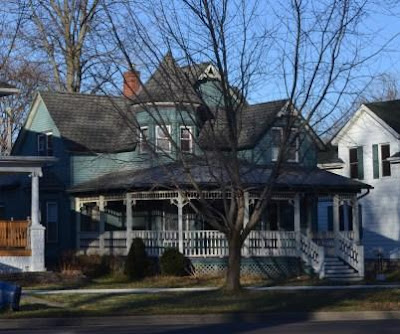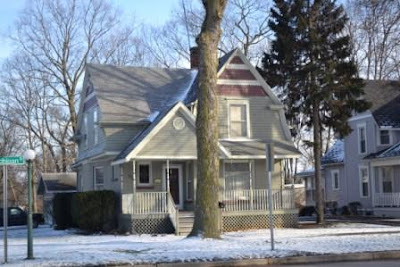 |
| Plymouth's most glorious main street bridging the Wythougan and leading into its Downtown |
Recently I was made aware of a rather uncomplimentary blog post regarding one of Indiana's most unique little crossroads cities, Plymouth. More specifically, the blogger compared the picturesque town's supposed shortfalls with its neighbor to the east, Warsaw. The Ostrander blog post is here if you find it necessary to read his defenseless (and rather silly, exaggerated) scorn of Plymouth whilst heaping undue accolades upon his beloved Warsaw.
Indeed I suspect that Ostrander is a native of the wannabe Kokomo on U.S. 30, and likely participated in sport at its school, that looks like a prison, where his disdain really stems from the age-long rivalry between the cities. To the contrary, I am not a native of Plymouth but am quite familiar with the city. The charming town of Plymouth was situated on a river dubbed "Wythougan" by the Native American, at the crossing of Indiana's most historic and important road, the Michigan Road. Early residents named the budding village in honor of the settlement our Puritan forefathers, who sailed but with their faith, staked out that would become the foundation of a new nation.
No, indeed, Plymouth's streets are not paved with gold either. But they are shaded by the most magnificent trees that define the main street as, in the words of university professors, the most impressive thoroughfare in all of Northern Indiana, Warsaw included. And at this time of year the main street is illuminated in gold from its living sentries stationed along its sidewalks. Added to the charm of this main street is its historic streetlights that sparkle like diamonds as you stroll the broad sidewalks at night. And what can Warsaw say to this? Within months Plymouth will boast its main street as the longest contiguous corridor on the National Register of Historic Places in Indiana, save Meridian Street in Indianapolis.
I cannot even determine where Warsaw stops and starts as the stoplights keep reproducing.
Furthermore, Plymouth-while bypassed not once, but twice, maintains one of the most attractive downtowns in Northern Indiana. The city embraces its unique place in not only history, but in geography, as a crossroads of important routes now designated by the State of Indiana as State Scenic Byways. Warsaw can boast only stop-and-go traffic on U.S. 30 and a convoluted street grid that defies even the most astute of minds. Plymouth's parks are strung around the city like precious gems in a necklace, the most important of which is underway in the city's downtown. Warsaw has a park, well removed from the city, that is used as a refuge for those wishing to escape the city's tired and worn neighborhoods. Warsaw turned its back on its best God-given feature, a lake, and chose to pollute it instead.
The Ostrander blog post pictured an ominous backdrop to the county courthouse situated in Plymouth. Unlike Warsaw's founders, Plymouth's early residents determined that the seat of government should be in the midst of the people because the government is elected by and for the people. This location amid neighborhoods is one of only two such placements in the entire state. Warsonians determined that their government should be under the close scrutiny and control of its bankers, lawyers, and merchant-tycoons. Not the people.
So let us talk about Plymouth's people.....true salt of the earth people. Plymouthites are those who roll up their sleeves and get to work, unlike the neighboring Warsonians who sit and wait for one of their medical industries to gift them something. Plymouth people are more than generous, in fact, one day nearly a year ago, is being heralded as one of the biggest days of benevolence ever seen in Indiana where hundreds participated in a single day of giving that resulted in over a half-million dollars raised for the community......whilst Warsaw waits for more handouts.
And yes, Plymouth's mayor's head is bald, as Ostrander pointed out, but it is well-polished, like so many of the city's fine residences. And unlike Warsaw's meager coffers, Plymouth-through the leadership of its state-recognized clerk-treasurer-has amassed wealth that would make a city ten times Plymouth's size green with envy.
 |
| Warsaw's answer to both industry and culture |
For all that Plymouth may lack, this is certain, its residents do not lack hearts of gold, the hearts of champions, and the steely-grit and determination to never become like Warsaw.
Actually, Warsaw's not all that bad......the post is just in keeping with the tenor of the Ostrander post.

























 Another noteworthy bridge is the Pennsylvania Railroad/Michigan Street viaduct constructed about 1900. This is one of the more identifiable Plymouth landmarks. The steel pony plate girder truss style bridge crosses Michigan Street just south of the Yellow River and rests on massive limestone abutments and center pier. A train once derailed at this location sending rail cars over the north side of the rail to the street below. What would become known as the Pennsylvania Railroad was constructed through Plymouth in 1856. Two other 1900 pony plate girder truss bridges are also located in Plymouth along this rail line. So if you're keeping track-that's 8 historic bridges....not bad for a little town.
Another noteworthy bridge is the Pennsylvania Railroad/Michigan Street viaduct constructed about 1900. This is one of the more identifiable Plymouth landmarks. The steel pony plate girder truss style bridge crosses Michigan Street just south of the Yellow River and rests on massive limestone abutments and center pier. A train once derailed at this location sending rail cars over the north side of the rail to the street below. What would become known as the Pennsylvania Railroad was constructed through Plymouth in 1856. Two other 1900 pony plate girder truss bridges are also located in Plymouth along this rail line. So if you're keeping track-that's 8 historic bridges....not bad for a little town.
 The Prosper Ball house was constructed in the Dutch Colonial Revival style in about 1915. It is an exceptional example of the style. Prosper and Alice Ball were the parents of five children: Alexis, Mary, Marcellus, Clement, and Richard. In 1920 Prosper’s brother, Alpha, and his mother, Catherine, were also living with the family in this house. Prosper’s father, Phillip Jacob Ball, was a native of Germany who settled in Plymouth in 1872. Phillip founded the drygoods and clothing store in partnership with his brother-in-law, Mr. Carabin. That partnership was dissolved in 1890 after which time the firm became known as Ball & Company. Prosper and his two brothers, Alpha and Jerome, became sole owners of the business after their father’s death. In 1908 the business was the largest merchant shop in Plymouth and employed fifteen people. The home remained in the Ball family into the 1950s.
The Prosper Ball house was constructed in the Dutch Colonial Revival style in about 1915. It is an exceptional example of the style. Prosper and Alice Ball were the parents of five children: Alexis, Mary, Marcellus, Clement, and Richard. In 1920 Prosper’s brother, Alpha, and his mother, Catherine, were also living with the family in this house. Prosper’s father, Phillip Jacob Ball, was a native of Germany who settled in Plymouth in 1872. Phillip founded the drygoods and clothing store in partnership with his brother-in-law, Mr. Carabin. That partnership was dissolved in 1890 after which time the firm became known as Ball & Company. Prosper and his two brothers, Alpha and Jerome, became sole owners of the business after their father’s death. In 1908 the business was the largest merchant shop in Plymouth and employed fifteen people. The home remained in the Ball family into the 1950s.






 1929 Wards Store in Plymouth
1929 Wards Store in Plymouth Restoring the Spirit of Progress
Restoring the Spirit of Progress Wards Store Restored, 1997
Wards Store Restored, 1997












